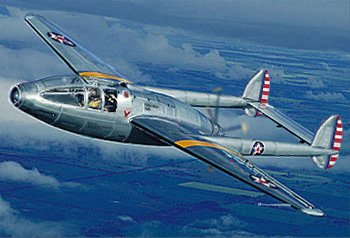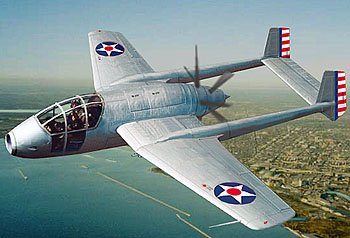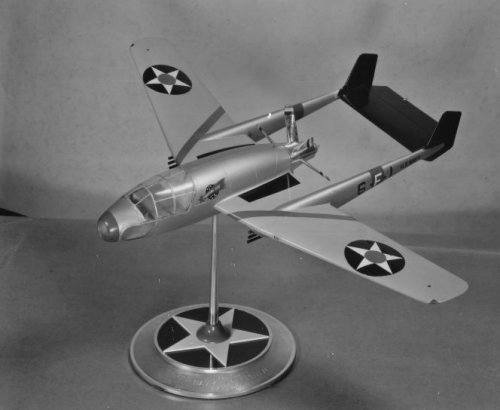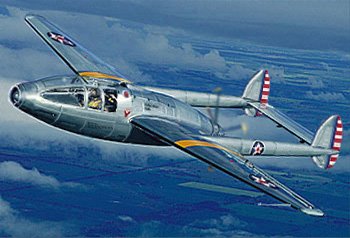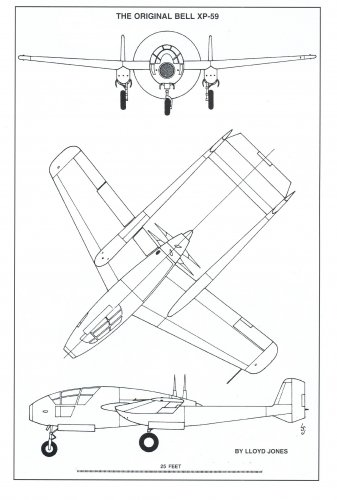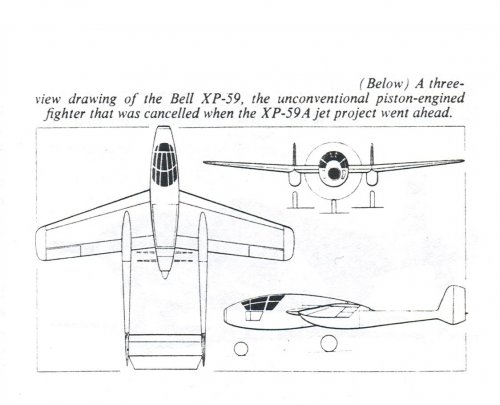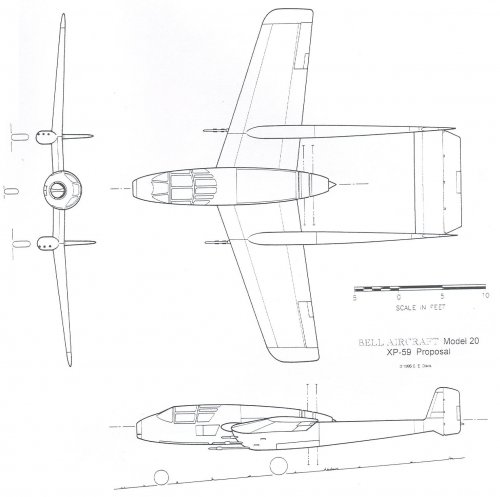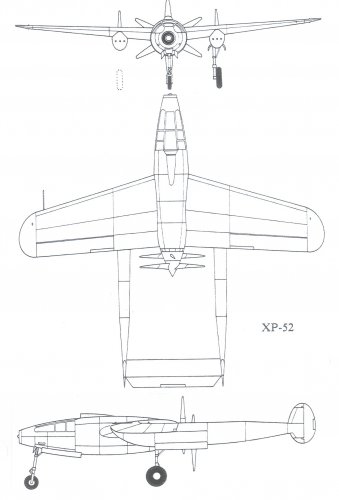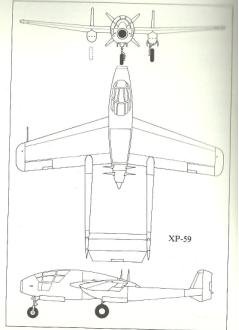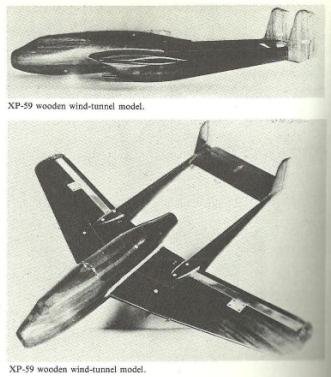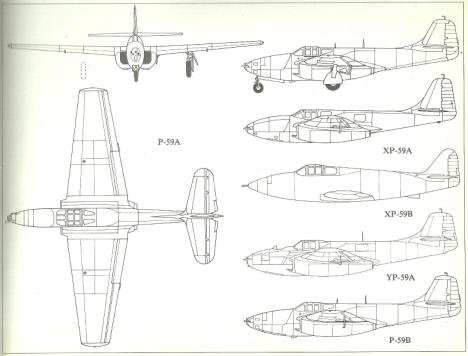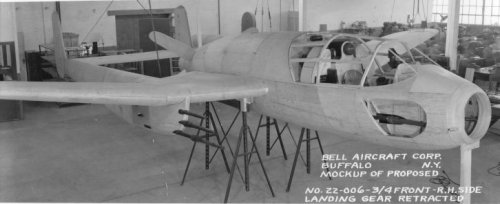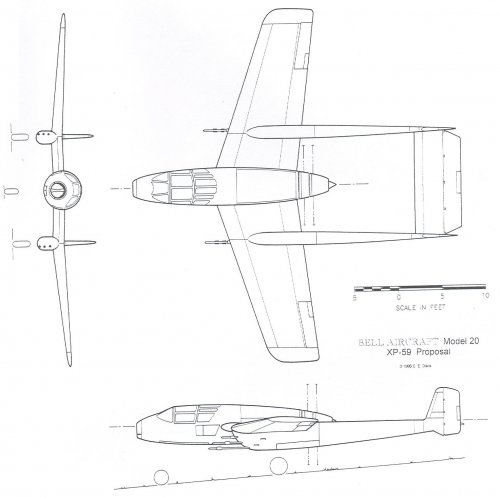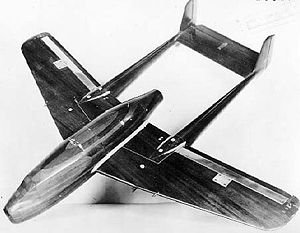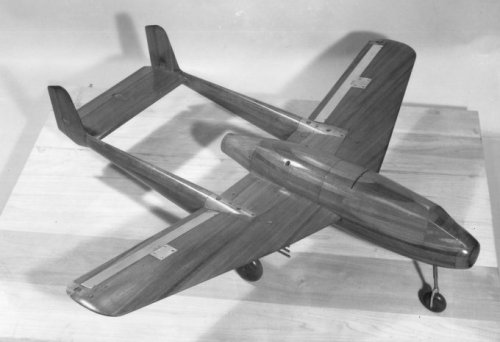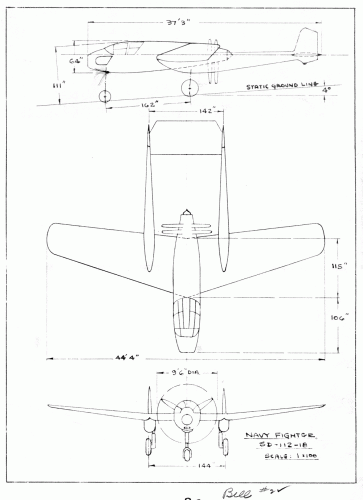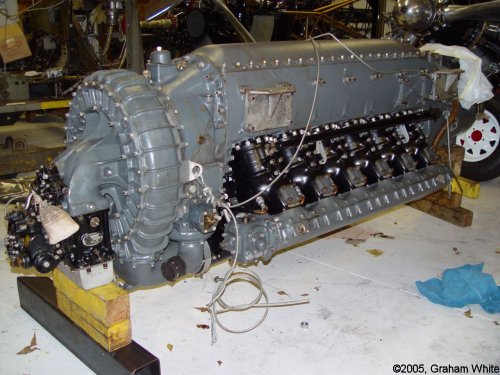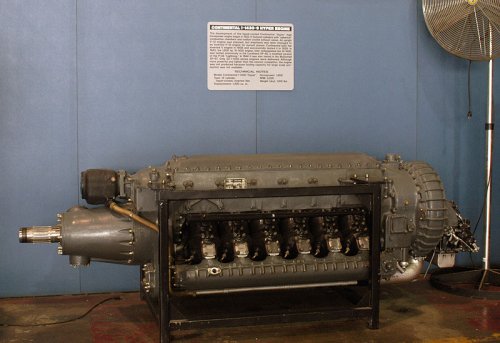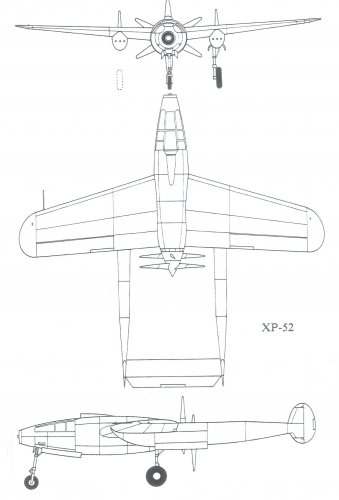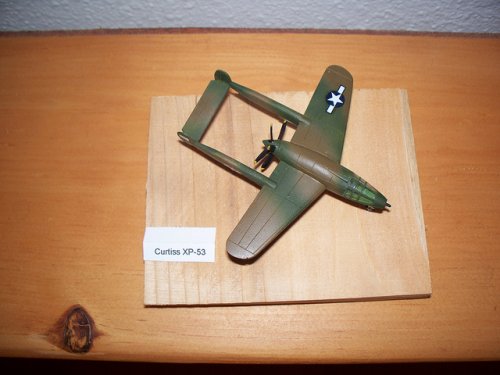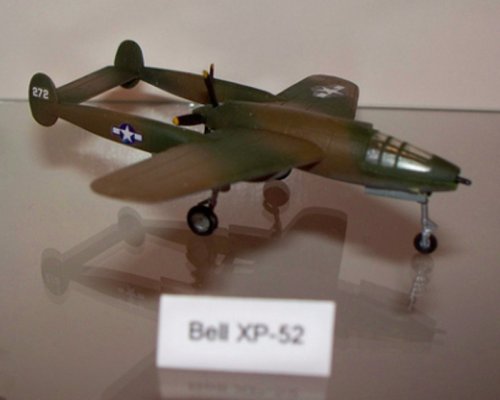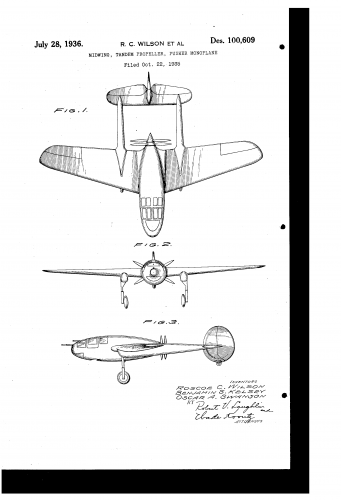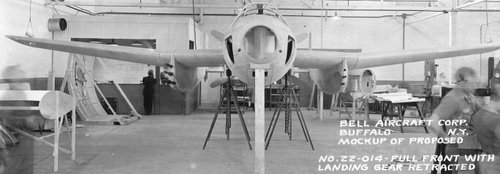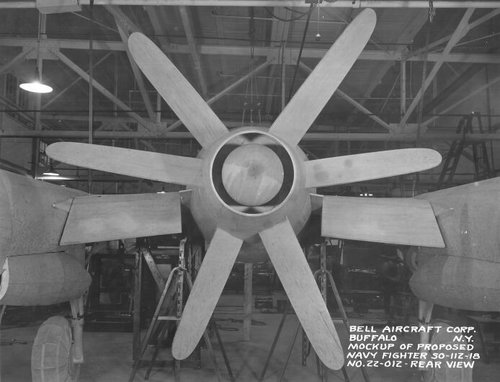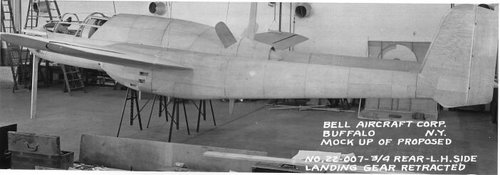I don't post over here much, but I'm a little surprised that no one's mentioned the Bell XP-52. It was designed in response to the same R-40C RFP that was mentioned here earlier. It was a twin-boom configuration aircraft, with an inline engine driving a pusher prop and nose-mounted cannon armament. I've seen images various places online, but can't seem to lay hands on any of them at the moment.
You are using an out of date browser. It may not display this or other websites correctly.
You should upgrade or use an alternative browser.
You should upgrade or use an alternative browser.
Bell Aircraft's twin-boom fighter projects (XP-52, XP-59, etc.)
- Thread starter Jschmus
- Start date
- Joined
- 22 January 2006
- Messages
- 4,216
- Reaction score
- 2,018
Hi Jschmus,
Your posts are welcome
XP-52 is an intriguing design. You're right that references can be found where it's described as an R-40C submission. But many others point in the other direction. In the list I published on post#2 from the present topic, which in my opinion comes from an authoritative source, the Model 16/XP-52 doesn't appear. According to it, Bell tendered its Model 13 to R-40C. Model 13 looked more like an enlarged P-39. In Bell Aircraft (Ed Putnam) I think there is a mistake on the description because the aircraft is associated to 1941 as "date of design". 1941 is too late for R-40C, however I think the real figure should be 1939 cited on Wings (August,1996 issue). BTW, there is an interesting windtunnel model with a different tail layout. I strongly recommend that magazine, which is still available, to all US pre-1945 fighter enthusiasts.
My personal opinion is Model 16 was designed a few months after Model 13, after Hap Arnold pushed for advanced lineal engine fighter (what latter was formaly requested as R-40C). While Model 13 was Bell's entry to R-40C, Model 16 could have been a parallel and more radical study based on Douglas DS-312A. May be Model 13 was to be R-40C "Phase One" entry and Model 16 would have been their entry for R-40C "Phase Two". As you probably know "Phase One" admitted designs based on existing technology while "Phase Two" demanded performance to the limits on totally new designs. The powerplant selected for Model 16 was the 1350 hp Continental IV-1430 which development was plagued with cooling problems that ended with its cancellation. Bell re-engined and thus re-designed its Model 16 into what the USAAC assigned the XP-59 designation. I don't know its Bell design number. XP-59 engine was the powerful and already in production Pratt&Whitney R-2800 Double Wasp radial (the same engine that powered F6F, Corsair or P-47 fighters). However, the USAAC cancelled the XP-59 in 1941 probably because it was found that it was not to be a revolutionary performer. By that time, late 1941, the USAAC selected Bell to concentrate all efforts into the production of US first operational jet fighter. Work on XP-59 was to judged a distraction of resources and thus terminated. However USAAC assigned the XP-59A designation to the jet to cover that program with the unrelated XP-59 work.
Regards,
Antonio
Your posts are welcome
XP-52 is an intriguing design. You're right that references can be found where it's described as an R-40C submission. But many others point in the other direction. In the list I published on post#2 from the present topic, which in my opinion comes from an authoritative source, the Model 16/XP-52 doesn't appear. According to it, Bell tendered its Model 13 to R-40C. Model 13 looked more like an enlarged P-39. In Bell Aircraft (Ed Putnam) I think there is a mistake on the description because the aircraft is associated to 1941 as "date of design". 1941 is too late for R-40C, however I think the real figure should be 1939 cited on Wings (August,1996 issue). BTW, there is an interesting windtunnel model with a different tail layout. I strongly recommend that magazine, which is still available, to all US pre-1945 fighter enthusiasts.
My personal opinion is Model 16 was designed a few months after Model 13, after Hap Arnold pushed for advanced lineal engine fighter (what latter was formaly requested as R-40C). While Model 13 was Bell's entry to R-40C, Model 16 could have been a parallel and more radical study based on Douglas DS-312A. May be Model 13 was to be R-40C "Phase One" entry and Model 16 would have been their entry for R-40C "Phase Two". As you probably know "Phase One" admitted designs based on existing technology while "Phase Two" demanded performance to the limits on totally new designs. The powerplant selected for Model 16 was the 1350 hp Continental IV-1430 which development was plagued with cooling problems that ended with its cancellation. Bell re-engined and thus re-designed its Model 16 into what the USAAC assigned the XP-59 designation. I don't know its Bell design number. XP-59 engine was the powerful and already in production Pratt&Whitney R-2800 Double Wasp radial (the same engine that powered F6F, Corsair or P-47 fighters). However, the USAAC cancelled the XP-59 in 1941 probably because it was found that it was not to be a revolutionary performer. By that time, late 1941, the USAAC selected Bell to concentrate all efforts into the production of US first operational jet fighter. Work on XP-59 was to judged a distraction of resources and thus terminated. However USAAC assigned the XP-59A designation to the jet to cover that program with the unrelated XP-59 work.
Regards,
Antonio
Could you tell me where, please? I haven't thought of a search strategy that doesn't produce things like "drawings" in great quantity!Wings (August,1996 issue). BTW, there is an interesting windtunnel model with a different tail layout. I strongly recommend that magazine, which is still available,
- Joined
- 22 January 2006
- Messages
- 4,216
- Reaction score
- 2,018
Ups, you're right smurf.
I've visited Wings web at:
http://www.airwingmedia.com/
and "paper" mags are no more available. It seems that they are scanning their back issues into CD/DVD support for sale. They have started from 2006 and counting down. The older "year" available is 1999 so you still have to wait to 1996.
I don't like very much that formula. I love the pdf but I rather prefer to buy single issues.
I've visited Wings web at:
http://www.airwingmedia.com/
and "paper" mags are no more available. It seems that they are scanning their back issues into CD/DVD support for sale. They have started from 2006 and counting down. The older "year" available is 1999 so you still have to wait to 1996.
I don't like very much that formula. I love the pdf but I rather prefer to buy single issues.
Thanks for the link Pometablava. I suppose you beat me to the paper collection offer!?!...
If you get it, let me know what duplicates you might then have that might interest me - the Aug 1996 especially.
I agree that the whole lot on disc is a bit pricey for what I might want, especially when the one I want isn't there yet!
If you get it, let me know what duplicates you might then have that might interest me - the Aug 1996 especially.
I agree that the whole lot on disc is a bit pricey for what I might want, especially when the one I want isn't there yet!
- Joined
- 25 July 2007
- Messages
- 4,302
- Reaction score
- 4,198
pometablava said:found this beautiful painting on my HDD
Thanks Pometablava! :-*
I did that image about four (?) years ago. It was my first attempt at rendering a 'secret project'. Attached is my second.
Attachments
- Joined
- 22 January 2006
- Messages
- 4,216
- Reaction score
- 2,018
Thanks for the link Pometablava. I suppose you beat me to the paper collection offer!?!...
Well, actually not. First I have to wait for Skybolt's PM. 140$ for the full collection is quite a reasonable price for me but I'm almost sure that P&P will be astronomical if that collection would be shipped to Spain from the USA. So...I'm not very confident on seeing it on my home. :'(. Wings&Airpower was a first class publication with precisse and well researched contents and the rarest historical pics. I'll keep you updated anyway.
Apophenia,
I didn't knew you were the author of that XP-52 drawing, it's a pleasure to be in the forum with artists like you. Thanks again for that great XP-59 render.
- Joined
- 25 July 2007
- Messages
- 4,302
- Reaction score
- 4,198
Thanks Pometablava.
The Bell images were part of a site I was mounting of 'X' designs. I did the XP-39 (aft cockpit), XP-52, XP-59, XP-38 variations, etc. I had just started on bombers (XB-30) when my IP tanked ...
The Bell images were part of a site I was mounting of 'X' designs. I did the XP-39 (aft cockpit), XP-52, XP-59, XP-38 variations, etc. I had just started on bombers (XB-30) when my IP tanked ...
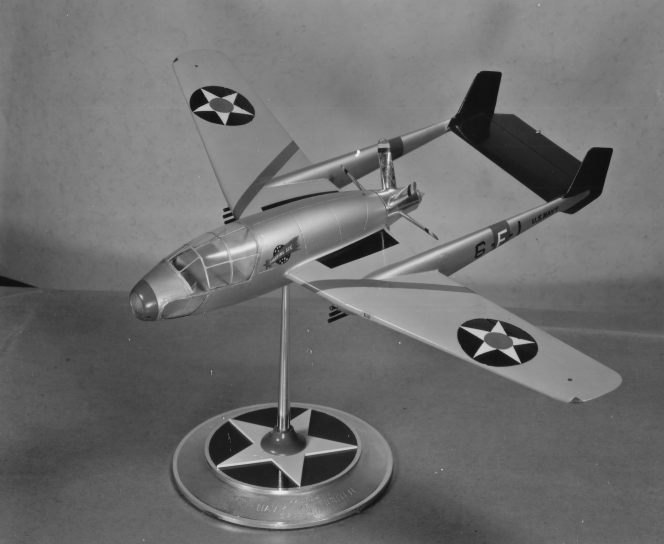
Photos of the full scale mockup at the Cultish Blog of Imperialist Fascist Kool-Aid Doom.
- Joined
- 22 January 2006
- Messages
- 4,216
- Reaction score
- 2,018
Photos of the full scale mockup at the Cultish Blog of Imperialist Fascist Kool-Aid Doom.
Great pics, thanks a lot Scott!
SlickDriver
ACCESS: Confidential
- Joined
- 20 June 2006
- Messages
- 161
- Reaction score
- 35
Thanks all!
Was wondering what the first designation would have looked like.
Was wondering what the first designation would have looked like.
- Joined
- 25 June 2009
- Messages
- 14,759
- Reaction score
- 6,165
- Joined
- 25 July 2007
- Messages
- 4,302
- Reaction score
- 4,198
Stargazer: xp-59.jpg was, of course, based on the photo of the windtunnel model and a 3-view. Alas, I mistook the access panels beneath the cockpit for additional glazing -- which might have been handy on the navalized Model 19 ;D
XP-52 paint.jpg was based on a 3-view from the same source (Angelucci's "The American Fighter", IIRC).
XP-52 paint.jpg was based on a 3-view from the same source (Angelucci's "The American Fighter", IIRC).
archipeppe
ACCESS: Top Secret
- Joined
- 18 October 2007
- Messages
- 2,435
- Reaction score
- 3,165
Justo Miranda said:Unknown source
It seems to be simply a P-39 fuselage and (perhaps) wings coupled with two jet engines "a la Meteor" more than the Su-9/11 that obviously shows the influence of German me-262.
Stargazer2006 said:Excellent! Thanks for sharing. What's the source for these? Never saw them before!
Unknown source!
- Joined
- 25 June 2009
- Messages
- 14,759
- Reaction score
- 6,165
New NACA pictures of the original XP-59 wind-tunnel model, from NASA's CRGIS website.
High-res versions can be downloaded here:
http://crgis.ndc.nasa.gov/historic/Additional_Photos_for_12-Foot_Low_Speed_Tunnel_2#XP-59
High-res versions can be downloaded here:
http://crgis.ndc.nasa.gov/historic/Additional_Photos_for_12-Foot_Low_Speed_Tunnel_2#XP-59
Last edited by a moderator:
- Joined
- 25 June 2009
- Messages
- 14,759
- Reaction score
- 6,165
blackkite said:Hi! 59?
Not quite. As the first picture's reference number suggests, this is the Navy's Model 22, a competitor of the Grumman F7F.
blackkite
Don't laugh, don't cry, don't even curse, but.....
- Joined
- 31 May 2007
- Messages
- 8,821
- Reaction score
- 7,721
Almost same design?Skyblazer said:blackkite said:Hi! 59?
Not quite. As the first picture's reference number suggests, this is the Navy's Model 22, a competitor of the Grumman F7F.
- Joined
- 25 June 2009
- Messages
- 14,759
- Reaction score
- 6,165
blackkite said:Almost same design?
Almost, yes.
Attachments
blackkite
Don't laugh, don't cry, don't even curse, but.....
- Joined
- 31 May 2007
- Messages
- 8,821
- Reaction score
- 7,721
XP-52 model, etc. 52 and 59 were also almost jet fighter.
XP-52's engine was Continental XIV-1430-5 12-cylinder, liquid-cooled, inverted V type.
XP-52 engine cooling system is hard to understand,too. I can't find any radiator cooling air outlet. Same as post war SNCASO S.O.8000?
Perhaps radiator cooling air inlet is located at the nose of the aircraft. ;D
XP-52's engine was Continental XIV-1430-5 12-cylinder, liquid-cooled, inverted V type.
XP-52 engine cooling system is hard to understand,too. I can't find any radiator cooling air outlet. Same as post war SNCASO S.O.8000?
Perhaps radiator cooling air inlet is located at the nose of the aircraft. ;D
Attachments
blackkite said:Perhaps radiator cooling air inlet is located at the nose of the aircraft. ;D
Precisely. The radiators for the Bell pusher fighters were located in a duct in the nose of the aircraft.
I've always thought that this might ahve been part of the reason why the pusher P-59's designation was re-used for the Bell jet. Leaks about a new jet fighter might be dismissed on the grounds that the source of the leak misinterpreted the radiator duct as a nose intake.
- Joined
- 26 May 2006
- Messages
- 34,928
- Reaction score
- 15,798
- Joined
- 25 June 2009
- Messages
- 14,759
- Reaction score
- 6,165
hesham said:maybe this twin boom patent airplane of 1935,inspired the XP-52 design,it was from
Mr. Oscar A. Swanson,Roscoe C. Wilson and Benjamin S. Kelsey.
https://www.google.com/patents/USD100609
The location should ring a bell. In fact we've discussed these engineers elsewhere (when we talked about the misidentified "Martin XB-16" project, because Swanson and Wilson were also involved in it). "Dayton, Ohio" indicates that these were Army Air Corps engineers drafting concepts for companies to use as starting points. So perhaps this could have inspired Bell, though I think the configuration for that airplane (a twin-boom cabin pusher) was something that was pretty much "in the air" at the time with many civilian "safety planes" such as the Stearman-Hammond Y-1S for instance.
blackkite
Don't laugh, don't cry, don't even curse, but.....
- Joined
- 31 May 2007
- Messages
- 8,821
- Reaction score
- 7,721
Hi! Navy's Model 22, a competitor of the Grumman F7F.
http://www.theaerodrome.com/forum/showthread.php?t=70072
http://www.theaerodrome.com/forum/showthread.php?t=70072
Attachments
Last edited:
Similar threads
-
Praga E-52 Twin Boom Single Seat Fighter Project
- Started by hesham
- Replies: 4
-
Howell Dolphin Twin-Boom Pusher Aircraft
- Started by hesham
- Replies: 0
-
Robertson Twin-Boom Pusher Aircraft Project
- Started by hesham
- Replies: 3
-
Al-Aire AL-2 Tijerete Twin Boom Light Aircraft Project
- Started by hesham
- Replies: 0
-
Gene Turner/Adams Aeronatics T-100D Twin Boom Light Aircraft & Projects
- Started by hesham
- Replies: 4

